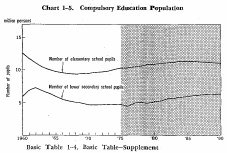| Home > Policy > White Paper, Notice, Announcement > White Paper > EDUCATIONAL STANDARDS IN JAPAN 1975 > CHAPTER1 2 (1) | ||
As of 1975, the enrollment in elementary schools and lower secondary schools stood at 10,370,000 persons and 4,760,000 persons respectively, with their combined total of 15,130,000 persons accounting for 60% of the total educational population (25,160,000) of the country.
Transition in enrollment in elementary and lower secondary schools during the last 15 years and its projection for the coming 15 years are shown in Chart 1-5, which suggests that, reflecting the high rate of enrollment in those schools, a change in the number of enrollment in these schools of compulsory education is equivalent to a change in the population of children in the comparable age group. The enrollment in elementary schools was in continuous decline from the peak of 13,490,000 in 1958 to 9,380,000 in 1968, but turned upward again in 1969, exceeding the 10 million mark in 1974. It is expected to maintain growth in the future, reaching a peak of about 12,400,000 around 1984 and then turn to gradual decline. The enrollment in lower secondary schools declined continuously from the peak of 7,330,000 in 1962 to 4,690,000 in 1972 and then stayed at the 1972 level until 1975. As in the case of elementary schools, enrollment in lower secondary schools is also projected to turn upward gradually in the future to about 6,200,000 in 1989.

Number of Pupils Temporarily or Permanently Exempted from the Obligation to Attend School
As of 1975, there were a total of 13,100 pupils, including 7,500 elementary school pupils and 5,600 lower secondary school pupils, who were temporarily or permanently exempted from their obligation toattend school due to mental and/or physical disorders or other reasons. While this figure was less than half of the 27,000 recorded in 1960, the decrease during this period is attributable chiefly to such steps as the increase in the number of schools for the otherwise handicapped and special classes.
| Back to Top | MEXT HOME |